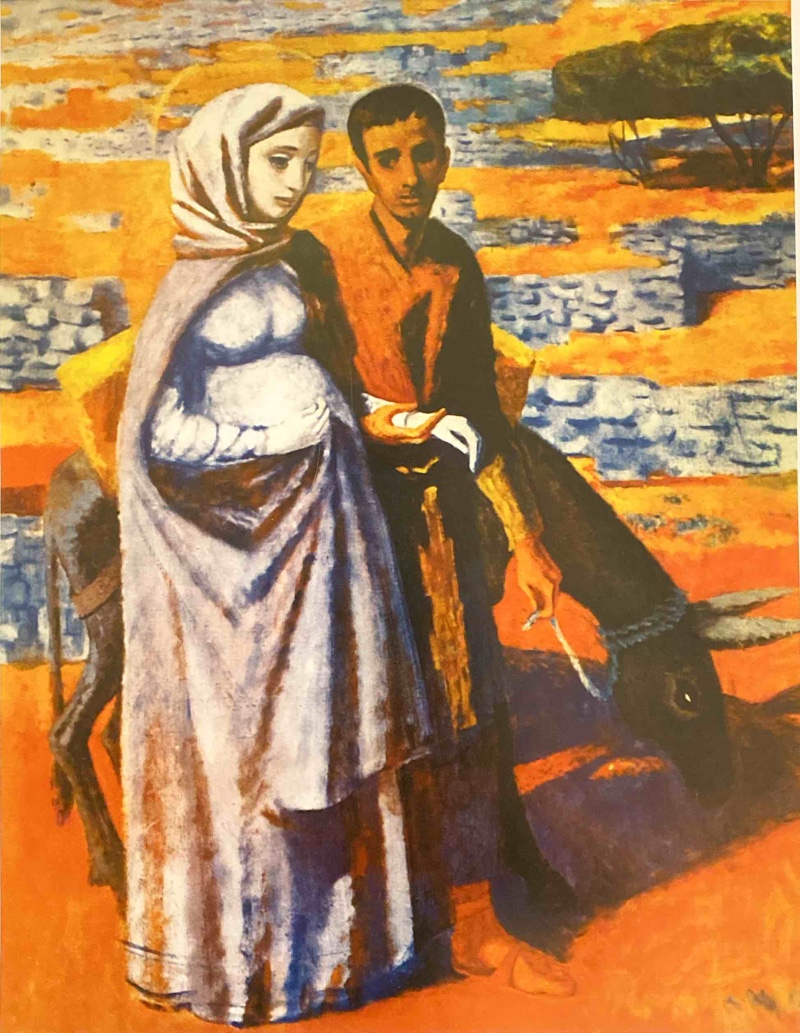It’s time for my annual tribute to Christmas. Most of you reading this probably think Christmas is over, and these reflections on Advent are late. The waiting and anticipation for the incarnation of Jesus has happened. Last week. But not really. In the Orthodox Christian tradition, Christmas is on January 7. It depends on your perspective! Or, as a Bosnian friend contends—who does not acknowledge a particular day to celebrate the birth of Jesus—every day is Christmas for him. I take his point, but in the case of Christmas on a daily basis, I fear it would lose some of the mystery and power.
On the other hand, the consequences of the birth, life, death, and resurrection of Jesus are so interwoven into the fabric of the Christian life that it is hard to distinguish where the wonder of one part begins or ends in relation to the others. Nor is it even necessary to have clear beginnings and endings. I can be in awe, encouraged, or inspired by the birth, life, death, or resurrection of Jesus any day of the year. Indeed, I am. One difference of a designated date for celebrating Christmas is the community participation that transforms the event into something more significant, even a foretaste of heaven.
My Christian faith heritage did not have an Advent tradition of lighting candles representing hope, peace, joy, and love during the four weeks of anticipation leading up to Christmas Day. However, many faith traditions do, and our church in Bosnia did. I grew to appreciate Advent as a means to focus and encourage our faith related to the birth of Jesus the Messiah, who ushered in a new understanding and reality of hope, peace, joy, and love, as he embodied each of these virtues, not only in his birth, but also in his death, and resurrection.
Therefore, it is fair to say that the advent of God monumentally magnifies each of these themes in the form of a human baby into the world. The potential to experience each of them at a profoundly deep level is difficult to explain unless you have done so. It requires faith in the events and the person of Jesus set forth in Scripture. But even if I were a skeptic, I could at least imagine the potential to transform my life if these things were true.
Here are a few personal reflections on traditional Christmas passages from the Gospels that still affect me after thirty-five years of faith in Jesus the Messiah. This happens throughout the year, not only at Christmas time. Each of these passages represents a divine commingling of hope, peace, joy, love, and more, for just as they intersect, they also connect and reflect mercy and grace.
First, we read that Mary “…will give birth to a son, and you are to give him the name Jesus because he will save his people from their sins” (Matthew 1:21). This name literally means the Lord saves. I don’t know about you, but knowing well my own sinful disposition, this makes me very happy. I use happy in the joy-adjacent sense. Happy gets a bad rap by preachers and is often compared to a shallow and fleeting emotion connected to temporal things. I guess I am joyfully happy…and hopeful, too! For in Jesus and his gospel we have this hope as an anchor for the soul, firm and secure” (Heb 6:19), tied to the unchangeable, immovable promises of God who cannot lie.
Second, Jesus’ birth was the long-awaited fulfillment of prophecy from 700 years earlier (Isaiah 7:14)! “All this took place to fulfill what the Lord had said through the prophet: “The virgin will be with child and will give birth to a son, and they will call him Immanuel”–which means, “God with us. (Matthew 1:23). I’ve always been amazed by the number of Old Testament prophecies fulfilled in the birth, life, death, and resurrection of Jesus. There are over 300 by some estimates. As noted above, this produces a hopeful confidence in God that he will do what he says. This confidence results in deep peace for the person persuaded. The Hebrew term is shalom and means more than the absence of conflict. It includes the idea of wholeness, to be made complete. It is total well-being connected to knowing God and being known by God. This is the peace of God that transcends understanding (Phil 4:7) that Jesus conveys to his people (John 14:27). I have no other explanation for the emotional and mental equilibrium of the past thirty-five years other than the multi-faceted peace of God ushered in by the birth of the Messiah. Not only that but all of creation is headed towards restoring this perfect shalom-peace when Jesus returns to make all things new (Rev 21:5)! Hallelujah!
Third, these lowly shepherds are in a nearby field when “An angel of the Lord appeared to them, and the glory of the Lord shone around them, and they were terrified. But the angel said to them, ‘Do not be afraid. I bring you good news of great joy that will be for all the people, today in the town of David a Savior has been born to you; he is Christ the Lord” (Luke 2:11). Good news of great joy indeed. It is good to remember what it was like not to have faith. I recall moments in my former life that I contrast with born-again joy, peace, love, and hope. For example, once I standing at a bus stop around 1986, waiting for a ride to work. The absence of joy and the presence of pointlessness led me to walk home and go back to bed. But joy rooted in the gospel, like peace, hope, and love, is difficult to explain. Jesus seems to connect deep, divine joy to obedience and seeing God answer prayers (John 15:11, 16:23). The older I am, the more comfortable I am without answers to all my questions. There is real mystery in transcendence, as Moses assured the Israelites, “The secret things belong to the LORD our God, but the things revealed belong to us and to our children forever, that we may follow all the words of this law” (Deut 29:29). As for joy, may it be to us as Nehemiah instructed the people because of God’s presence, provision, and salvation, “Go and enjoy choice food and sweet drinks, and send some to those who have nothing prepared. This day is sacred to our Lord. Do not grieve, for the joy of the LORD is your strength” (Nehemiah 8:10). Amen again.
Fourth, forty days after his birth, Mary and Joseph take the baby to the temple to dedicate him. The Spirit moved a devout and righteous man named Simeon to enter the temple. Upon seeing the baby Jesus, “Simeon took him in his arms and praised God, saying: “Sovereign Lord, as you have promised, you now dismiss your servant in peace. For my eyes have seen your salvation, which you have prepared in the sight of all people, a light for revelation to the Gentiles and for glory to your people Israel” (Luke 2:28-32). In the birth of Jesus, Simeon’s hope to see the Redeemer of Israel with his own eyes had been fulfilled and fused with peace and joy.
Lastly, about two years after Jesus was born, the Magi from the East arrived in Bethlehem, “On coming to the house, they saw the child with his mother Mary, and they bowed down and worshiped him” and gave him gifts of gold, incense, and myrrh (Matthew 2:11). What?! Who does that to a toddler? The arrival of the Magi with their gifts overshadows a dark historical reality. Our modern depictions of Christmas with peaceful manger scenes and family gatherings make it easy to overlook the rough and crude circumstances into which Jesus was born. Historically, the Pax Romana (Roman Peace) of the day was a brutal and coercive peace enforced by cruel and unusual punishment to any and all threats to Roman authority. For example, Joseph and pregnant Mary were forced to travel 7-10 days on foot due to a compulsory Roman census. The arrival of the Magi, looking to worship “the one who has been born king of the Jews” (Matt 2:2), triggered fear and rage in the murderously cruel King Herod, Rome’s Jewish collaborator. Warned in a dream that Herod planned to kill the baby Jesus, who he viewed as a threat, the family fled to Egypt, another couple of week’s journey to a foreign land. When Herod discovered later that he’d been tricked, he gave orders to kill all the boys in Bethlehem and its vicinity who were two years old and under. Not only that, but this Christmas story includes the prophetic word of Simeon to Mary in the temple: “And a sword will pierce your own soul too” (Luke 2:35).
To put it bluntly—according to one of my favorite Substack writers, Bethel McGrew, quoting theologian, Klaas Schilder—Bethlehem inevitably leads to Golgotha. “The world wants to go to the former without the latter. They like Christmas, but not Good Friday. But we go to both”. It would seem that hope, peace, joy, and love are in danger. But looking backward, we understand that what happened at Golgotha empowers us to truly celebrate Christmas. Once our greatest enemy, death, was defeated, a new spiritual reality is opened up to us. Jesus called it an abundant life now (John 10:10), but only as a foretaste of a glorious eternity of perfect hope, peace, joy, and love.
So far, I have not discussed love. However, the love of God is like a banner over all these things. Grasping, even in part, this vast, unconditional divine love, has mystical, transformational, new-creation power. I can still be moved to tears when I sing the words of an old hymn, “Redeeming love has been my theme and shall be till I die.” That pretty much sums it up. The love of God in Christ Jesus, “who is the radiance of God’s glory and the exact representation of his being…” (Hebrews 1:3), and nothing in all creation can separate us from that love in Him (Romans 8:39)!
Like they say, you can’t make this stuff up.
Happy New Year!

